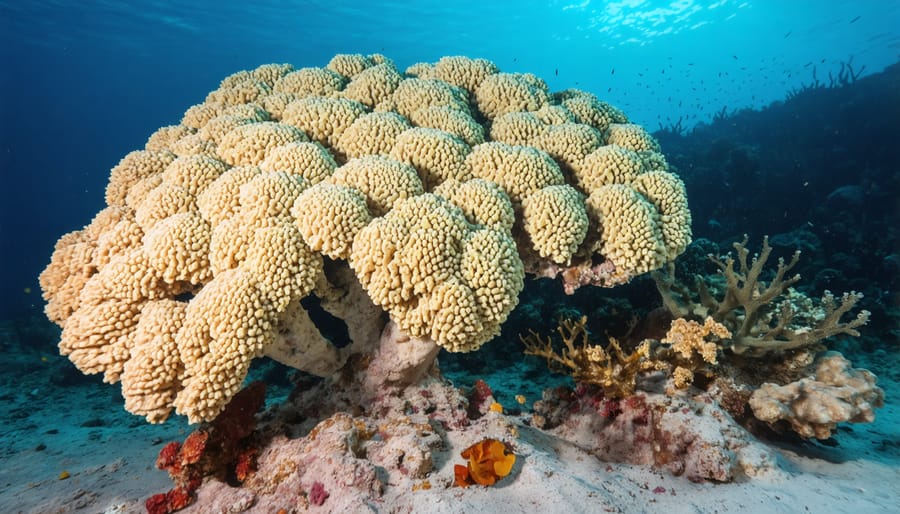
Our oceans are in crisis. Climate change is fundamentally altering marine ecosystems, with devastating consequences rippling from microscopic plankton to colossal whales. As atmospheric carbon dioxide levels soar, the oceans absorb the excess, leading to rising temperatures and increasing acidification. Entire habitats like coral reefs are being decimated. Species are dying off or being forced to migrate to cooler waters. Ocean currents and weather patterns are shifting.
The threats are urgent and undeniable. Yet there is still hope – if we act swiftly and decisively. By drastically reducing emissions, protecting vulnerable ecosystems, and letting science guide our policies and individual choices, we can help our oceans weather this storm. The cost of inaction is unthinkable. Our fate is inextricably tied to the health of our oceans. To save marine life is to save ourselves.
Rising Ocean Temperatures
Coral Bleaching
Rising ocean temperatures due to climate change are causing widespread coral bleaching events, threatening the survival of vibrant coral reefs worldwide. When water temperatures rise above a certain threshold, corals expel the symbiotic algae living within their tissues, which provide them with essential nutrients and their vibrant colors. Without these algae, the coral’s white skeleton becomes visible through its transparent tissue, giving the appearance of bleaching.
Bleached corals are not dead, but they are highly stressed and more susceptible to disease and mortality. If water temperatures return to normal quickly, corals can recover and regain their algal partners. However, as marine heatwaves become more frequent and intense due to climate change, coral reefs are experiencing more severe and prolonged bleaching events, leaving little time for recovery.
Mass bleaching events can lead to the death of vast expanses of coral, devastating entire reef ecosystems. The loss of coral reefs has far-reaching consequences for marine biodiversity, as they provide habitat, food, and shelter for countless species. Moreover, the degradation of coral reefs affects the livelihoods of millions of people who depend on them for food, income, and coastal protection.
To mitigate the impacts of coral bleaching, it is crucial to address the root cause: climate change. Reducing greenhouse gas emissions and adopting sustainable practices can help slow the rate of ocean warming and give coral reefs a better chance of adapting and surviving in the face of this global threat.


Species Migration and Extinction
As ocean temperatures rise due to climate change, many marine species are being forced to adapt by migrating to cooler waters. However, for some species, the rate of climate change is outpacing their ability to relocate, leading to population declines and potential extinction. Coral reefs, which are particularly sensitive to temperature changes, are experiencing widespread bleaching events as a result of prolonged exposure to warmer waters. When corals bleach, they expel the symbiotic algae that provide them with nutrients, leaving them vulnerable to disease and death.
In addition to corals, many fish and invertebrate species are also being impacted by rising ocean temperatures. Some species, such as cod and lobster, are shifting their ranges northward in search of cooler waters. However, this migration can disrupt established food webs and ecosystems, leading to cascading effects throughout the marine environment. Other species, such as some species of plankton and krill, are unable to migrate quickly enough to keep pace with changing temperatures, leading to population declines that can have ripple effects up the food chain.
The impacts of species migration and extinction extend beyond the marine environment, affecting human communities that rely on the ocean for food, livelihoods, and cultural traditions. As species shift their ranges or disappear altogether, traditional fishing grounds may become less productive, forcing communities to adapt their practices or face economic hardship. By taking action to mitigate climate change and protect marine habitats, we can help to ensure the survival of these vital species and the communities that depend on them.
Ocean Acidification
As the ocean absorbs increasing amounts of carbon dioxide from the atmosphere, a chemical reaction occurs that lowers the water’s pH, making it more acidic. This process, known as ocean acidification, has dire consequences for many marine organisms, particularly those with calcium carbonate shells or skeletons. When the water becomes more acidic, it reduces the availability of carbonate ions, making it harder for these creatures to build and maintain their protective structures.
Among the most vulnerable are species like corals, mollusks, and certain types of plankton. Corals, which provide vital habitats for countless marine species, struggle to grow and maintain their skeletons in more acidic water. This not only threatens the survival of the corals themselves but also the entire ecosystems they support. Similarly, mollusks such as oysters, clams, and mussels face challenges in building their shells, leading to thinner, more fragile structures that leave them more susceptible to predation and damage.
The impacts of ocean acidification extend far beyond individual species. As the populations of these shell-building organisms decline, it can disrupt entire food webs. Many of these creatures form the base of marine food chains, providing nourishment for larger animals like fish, seabirds, and marine mammals. When their numbers dwindle, it can have cascading effects throughout the ecosystem.
Furthermore, ocean acidification can have significant economic implications. Many coastal communities rely on shellfish harvesting and aquaculture for their livelihoods. As these industries struggle with declining populations and reduced shell quality, it can lead to job losses and financial hardship.
Addressing ocean acidification requires a concerted effort to reduce carbon dioxide emissions. By transitioning to clean energy sources, implementing energy efficiency measures, and protecting natural carbon sinks like forests and wetlands, we can help slow the rate of acidification and give marine life a better chance to adapt. Additionally, supporting research into the impacts of ocean acidification and potential mitigation strategies is crucial for developing effective conservation plans.
Changes in Ocean Currents
Nutrient Distribution Disruption
Climate change is altering ocean currents, leading to significant disruptions in the distribution of essential nutrients throughout marine ecosystems. These currents act as conveyor belts, transporting nutrients from deep waters to the surface, where they support the growth of phytoplankton, the foundation of the marine food web. As climate change modifies the intensity and patterns of these currents, the delicate balance of nutrient distribution is thrown off-kilter.
The consequences of this disruption are far-reaching. When nutrients are not distributed properly, phytoplankton populations can decline, leading to a cascade effect throughout the food web. Zooplankton, which feed on phytoplankton, may struggle to find sufficient food, impacting the survival of fish, marine mammals, and seabirds that depend on them. This disruption can lead to shifts in species distribution, changes in migration patterns, and even local extinctions.
Moreover, altered currents can lead to the formation of “dead zones,” areas where nutrient levels are so low that they cannot support marine life. These dead zones can expand rapidly, further exacerbating the challenges faced by marine organisms. As the climate continues to change, it is crucial that we take action to mitigate these impacts and protect the delicate balance of marine ecosystems.
Sea Level Rise
Sea level rise, one of the most visible consequences of climate change, is profoundly impacting marine ecosystems around the globe. As global temperatures continue to climb, the world’s ice caps and glaciers are melting at an unprecedented rate, causing ocean levels to surge. This phenomenon is not only reshaping coastlines but also threatening the delicate balance of coastal habitats that countless species depend on for survival.
Low-lying coastal areas, such as wetlands, mangroves, and salt marshes, are particularly vulnerable to rising seas. These unique ecosystems serve as essential nurseries for many marine species, providing shelter, food, and breeding grounds. As sea levels encroach upon these habitats, they are gradually being submerged and eroded, reducing the available space for the diverse array of life they support. In some cases, entire ecosystems are at risk of disappearing altogether, potentially leading to the extinction of the species that rely on them.
Moreover, rising sea levels are altering the salinity and temperature gradients in coastal zones, further disrupting the delicate equilibrium of these ecosystems. Changes in salinity can affect the growth and survival of certain species, while shifts in temperature can alter the timing of key life cycle events, such as migration and reproduction. As a result, the intricate web of relationships between organisms in these habitats is being strained, with far-reaching consequences for marine biodiversity.
The impact of sea level rise extends beyond the immediate coastal areas, as well. As more land is submerged, the available habitat for terrestrial species that depend on coastal regions is also shrinking. This can lead to increased competition for resources and heightened pressure on already stressed populations.
Taking Action
Reducing Carbon Footprint
In our everyday lives, we can take simple yet impactful steps to reduce our carbon footprint and contribute to slowing climate change. One of the most effective ways is by reducing greenhouse gas emissions through conscious choices in transportation, energy use, and consumption habits. Opting for public transit, carpooling, biking, or walking instead of driving alone can significantly cut down on carbon emissions. At home, using energy-efficient appliances, switching to renewable energy sources, and being mindful of energy consumption can make a substantial difference. Additionally, adopting a more plant-based diet, reducing food waste, and choosing products with minimal packaging can further shrink our carbon footprint. By making these eco-friendly lifestyle changes, we can collectively work towards mitigating the impacts of climate change on our precious marine ecosystems. Every individual action matters in the fight against climate change, and by spreading awareness and inspiring others to join the cause, we can create a ripple effect of positive change for the health of our oceans and the countless species that call them home.

Supporting Marine Conservation
Supporting marine conservation is crucial in the face of climate change’s devastating impacts on our oceans. Organizations like the Marine Biodiversity Science Center are at the forefront of studying these complex ecosystems and developing strategies to protect them. By conducting research on coral reefs, kelp forests, and other critical habitats, scientists can better understand the effects of rising temperatures, ocean acidification, and other climate-related stressors. This knowledge is essential for creating effective conservation plans and policies.
However, these organizations cannot do it alone. They rely on the support of individuals who are passionate about preserving our marine environment. By donating to marine conservation groups, volunteering for beach clean-ups, or simply spreading awareness about the importance of our oceans, everyone can play a role in protecting these vital ecosystems. Together, we can work towards a future where our oceans are healthy, resilient, and teeming with life. It’s not too late to make a difference, but we must act now before the damage becomes irreversible. By supporting marine conservation efforts, we can ensure that our oceans continue to thrive for generations to come.
Conclusion
The impacts of climate change on our oceans are both profound and alarming. Rising temperatures, ocean acidification, deoxygenation, and altered currents are disrupting delicate marine ecosystems, causing widespread coral bleaching, species migrations, and biodiversity loss. The consequences extend far beyond the ocean itself, threatening global food security, coastal communities, and the livelihoods of millions who depend on healthy seas.
However, amidst this crisis lies hope. By taking swift and decisive action, we can mitigate the worst effects of climate change on our oceans. This requires a collective effort from individuals, communities, and governments worldwide. We must reduce greenhouse gas emissions, transition to clean energy, protect critical marine habitats, and support sustainable fishing practices. Every action counts, from making conscious consumer choices to participating in beach cleanups and supporting marine conservation organizations.
As marine conservationists, educators, and concerned citizens, we have a responsibility to safeguard the incredible diversity of life in our oceans. By raising awareness, inspiring others, and leading by example, we can create a groundswell of support for marine conservation. Together, let us commit to being stewards of the sea, ensuring that the wonders of our oceans endure for generations to come. The time to act is now – the future of our planet’s marine biodiversity hangs in the balance.
Weston Goyette
Weston Goyette is a passionate advocate for marine conservation and sustainability. With a background in marine biology and environmental science, Weston has dedicated his career to exploring the intricate relationships within ocean ecosystems and promoting strategies to protect them. At the Marine Biodiversity & Sustainability Learning Center, Weston contributes insightful articles that delve into topics such as endangered species protection, climate change impacts on marine life, and sustainable practices for preserving our oceans. His writings aim to educate and inspire readers to take actionable steps toward environmental stewardship. Beyond his written work, Weston actively participates in community outreach programs, engaging with local schools and organizations to raise awareness about marine conservation. His commitment to both scientific research and public education makes him a valuable asset to the Center's mission.
